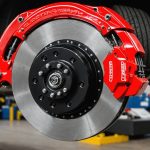Vehicle safety is a top concern for drivers and manufacturers alike. One often overlooked factor is wheelbase length, which significantly affects stability. A longer wheelbase can enhance ride comfort and improve handling, particularly during sharp turns or sudden obstacles. Understanding this relationship can empower consumers to make informed decisions when purchasing vehicles. This exploration reveals the intricate ways wheelbase length influences overall safety, encouraging a deeper appreciation for vehicle design.
Understanding Wheelbase Length
The wheelbase is a fundamental aspect of vehicle dimensions, representing the distance between the front and rear axles. This measurement is crucial in automotive terminology as it influences handling, stability, and interior space. A longer wheelbase often results in a smoother ride, as it can better absorb road irregularities. Conversely, a shorter wheelbase might enhance maneuverability, making it ideal for city driving.
In the same genre : What should I consider when choosing tires for optimal safety and performance?
Length Variations Across Vehicle Types
Different vehicles have varying wheelbase lengths tailored to their specific purposes. For instance, sedans typically have a moderate wheelbase, balancing comfort and agility. SUVs often feature a longer wheelbase to accommodate more passengers and cargo while ensuring a stable ride. In contrast, trucks may have either long or short wheelbases depending on their intended use, such as towing or off-road capabilities.
Common Misconceptions
A prevalent misconception is that a longer wheelbase always equates to better performance. While it can enhance certain aspects like stability, it may not suit all driving conditions. Understanding the wheelbase definition and its role in vehicle dimensions helps in making informed decisions when choosing a vehicle.
Also read : How can I safely transport pets in my vehicle?
Impact of Wheelbase on Vehicle Stability
Understanding how wheelbase length affects vehicle stability is crucial for evaluating a car's handling characteristics. A longer wheelbase generally enhances stability, especially during turns, by distributing weight more evenly across the vehicle. This distribution lowers the center of gravity, reducing the likelihood of rollovers and improving the car's grip on the road.
Handling Characteristics
A shorter wheelbase tends to make a vehicle more agile, allowing for quicker and sharper turns. However, this agility can come at the cost of stability, as a higher center of gravity might increase the risk of tipping during sudden maneuvers. Conversely, a longer wheelbase provides a more stable ride, but it may reduce the vehicle's ability to navigate tight corners efficiently.
Center of Gravity
The relationship between the wheelbase and the center of gravity is significant. A lower center of gravity, facilitated by a longer wheelbase, enhances vehicle stability by keeping the car grounded. This is particularly beneficial for high-speed driving or when carrying heavy loads, as it minimizes body roll and improves overall handling performance. Understanding these dynamics helps drivers choose the right vehicle for their specific driving needs.
Safety Considerations Related to Wheelbase Length
When evaluating vehicle safety, wheelbase length plays a crucial role. It can significantly impact crash test performance and rollover risk.
Crash Test Performance
A longer wheelbase often contributes to better crash test results. This is primarily because it enhances the vehicle's stability during impact, allowing for more effective energy distribution. Vehicles with longer wheelbases tend to absorb collision forces more efficiently, potentially reducing injury risk to occupants. Crash tests consistently demonstrate that stable vehicles, with balanced weight distribution, perform better in frontal and side-impact scenarios.
Rollover Risk
Rollover risk varies with wheelbase length. Vehicles with shorter wheelbases are generally more prone to rollovers, especially during sharp turns or sudden maneuvers. This is due to a higher center of gravity, which can lead to instability. Conversely, a longer wheelbase lowers the center of gravity, decreasing the likelihood of rollovers and enhancing overall safety.
Expert Opinions
Experts suggest that an optimal wheelbase length balances stability and maneuverability. While longer wheelbases offer enhanced safety during crashes and reduce rollover risks, they may not be ideal for all driving environments. Therefore, selecting the right wheelbase depends on individual safety priorities and driving conditions.
Real-World Examples of Wheelbase Effects
Understanding the impact of wheelbase length on vehicle performance can be illustrated through various case studies and automotive analysis.
Case Studies and Comparisons
In the automotive industry, sports cars and SUVs serve as prime examples of how wheelbase affects stability and handling. Sports cars, designed for speed and agility, often feature shorter wheelbases. This design choice enhances their maneuverability but may compromise stability at high speeds. Conversely, SUVs typically have longer wheelbases, which provide greater stability and comfort, particularly on rough terrains or during long-distance travel.
Performance Data Analysis
Automotive analysis often includes data from vehicle performance tests to assess how wheelbase influences stability. For instance, tests reveal that vehicles with longer wheelbases generally perform better in stability assessments, demonstrating lower rollover risks and improved crash test results. These tests highlight the trade-offs between agility and stability, depending on wheelbase length.
By examining these real-world examples, consumers can gain insights into how wheelbase length affects different vehicle types. This knowledge aids in making informed decisions, balancing the need for stability with the desired level of maneuverability.
Expert Insights and Opinions
Delving into the perspectives of automotive experts reveals the intricate considerations involved in wheelbase design. Automotive engineers emphasize that wheelbase length is not merely a measurement but a critical factor influencing a vehicle's overall dynamics. According to interviews with these experts, the design principles often balance between achieving optimal stability and maintaining maneuverability. This balance is crucial, especially in diverse driving conditions.
From an engineering perspective, a longer wheelbase is engineered to enhance stability, particularly at high speeds. However, it is essential to consider that while it provides a smoother ride, it may limit agility. Safety experts highlight the importance of wheelbase in crashworthiness, noting that vehicles with longer wheelbases often exhibit better crash test performance due to improved energy distribution during impacts.
In terms of industry standards, there is a consensus on maintaining a wheelbase length that ensures both safety and performance. Manufacturers adhere to these standards to meet regulatory requirements and consumer expectations. This adherence underscores the importance of wheelbase as a key parameter in vehicle design, influencing not only safety but also driving experience.
Visualizing Wheelbase Impact on Vehicle Dynamics
To comprehend the influence of wheelbase on vehicle dynamics, visual aids such as diagrams and charts are invaluable. These tools depict the intricate relationships between wheelbase length and factors like stability and handling.
Diagrams and Stability
Diagrams can effectively illustrate how a longer wheelbase contributes to enhanced stability. By showing the weight distribution across the axles, these visuals highlight the lower center of gravity achieved with a longer wheelbase. This distribution is crucial for maintaining balance during high-speed maneuvers or when carrying heavy loads.
Performance Metrics in Charts
Charts provide a comparative view of performance metrics across vehicles with varying wheelbase lengths. For instance, a chart may display data on crash test results, highlighting how longer wheelbases generally correlate with improved safety scores. Similarly, agility and maneuverability can be compared, showing how shorter wheelbases excel in tight cornering scenarios.
Enhancing Understanding
Visual aids not only clarify complex concepts but also make it easier to grasp the trade-offs between stability and agility. By presenting information in a visually engaging manner, these tools assist consumers in making informed decisions about vehicle selection based on their specific needs and preferences.











